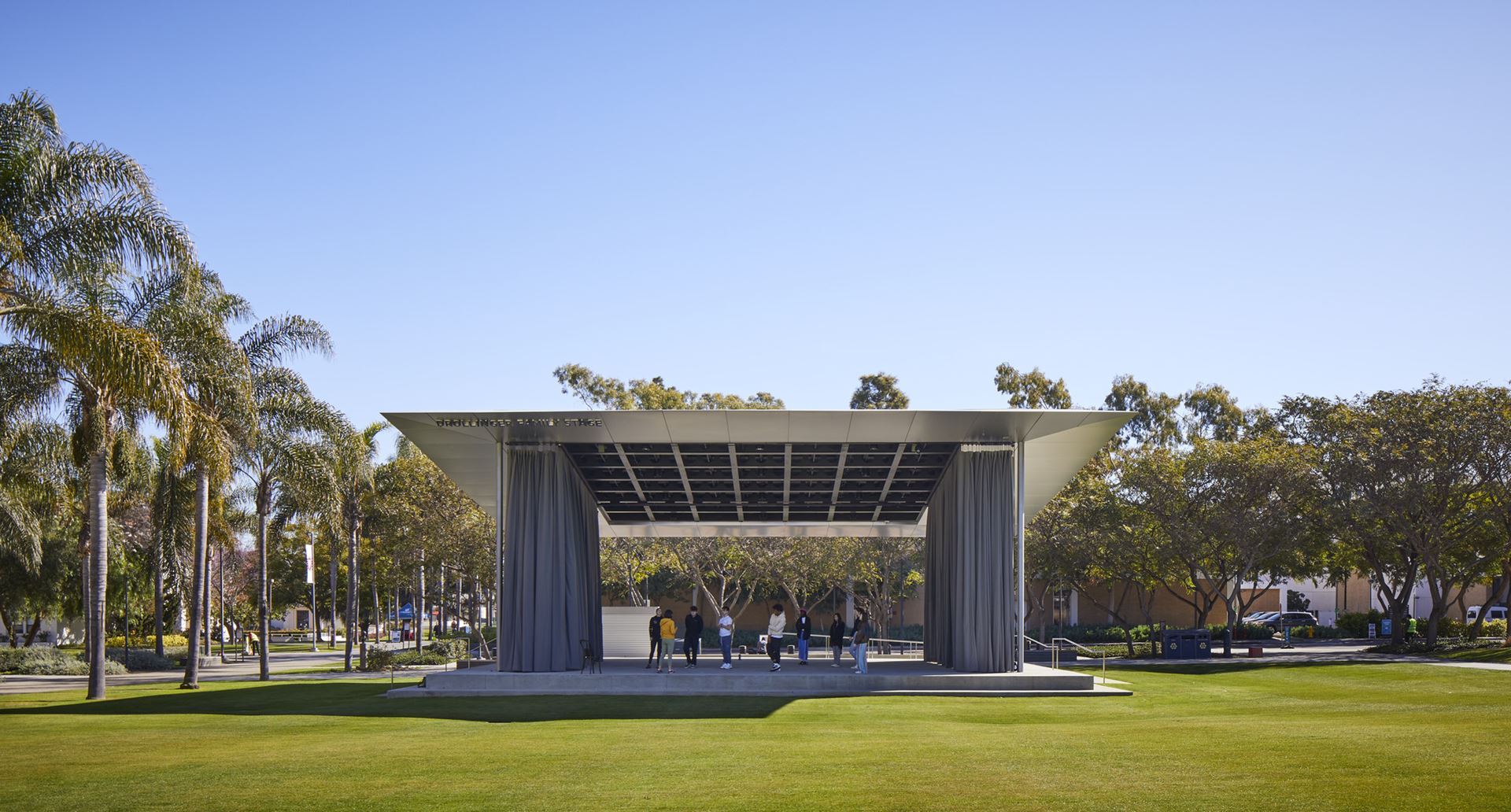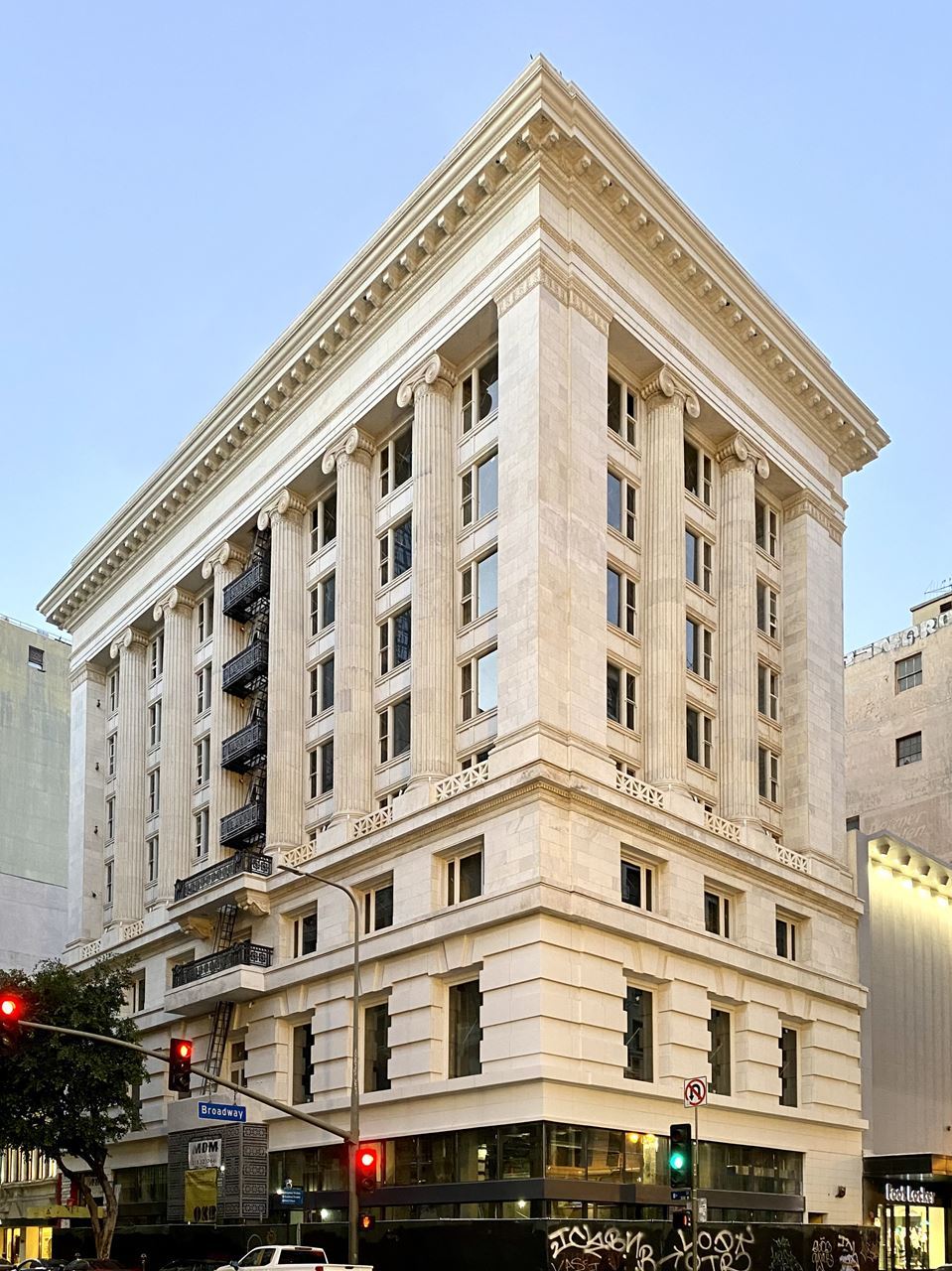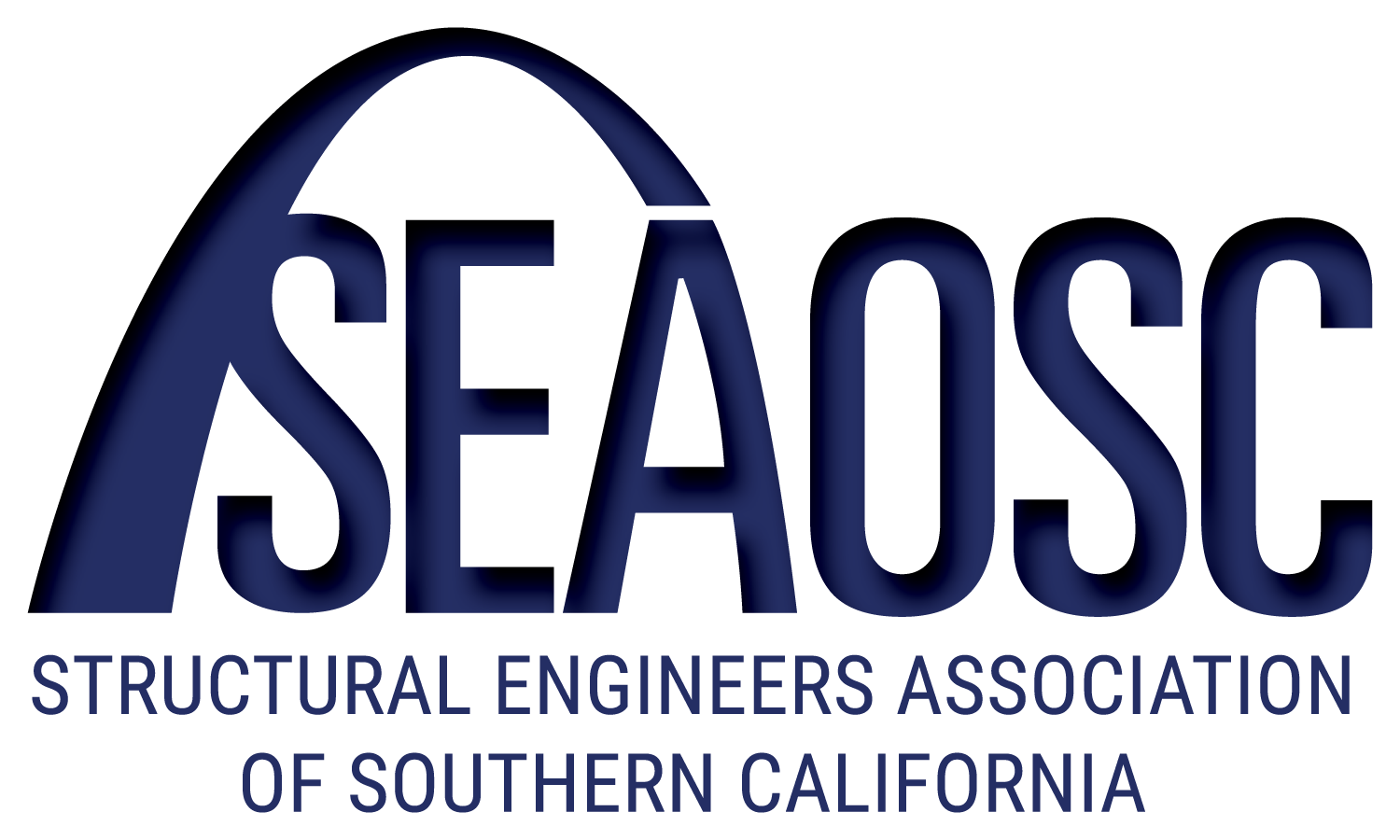|
2023 Structural Engineering Excellence Awards SEAOSC members in good standing are invited to cast their votes by scanning the QR code below starting
Special-Use Structures
Skidmore, Owings & Merrill | The Drollinger Family Stage Los Angeles, California Loyola Marymount University's Drollinger Family Stage is designed for complete programmatic flexibil using absolute minimal structure, strategic prefabrication, and precise systems integration. Located o central campus green, the 1,600 square foot stage provides a multipurpose venue for classes, performances, events and public announcements. In response to a changing environment, the open-ait venue is an intelligent, healthy, and cost-effective space for the campus and the broader community, The form of the Drollinger Family Stage is delicate; its canted roof appears on an open field as a floatin plane. A robust audiovisual system is embedded into the roof, which is on thin columns. The roof's metallic cladding was selected to be unobtrusive during dramatic nighttime shows. By eliminating visu clutter, the design enhances the theatricality and versatility of the space. With minimal structure and discreetly designed electrical and plumbing systems, it provides no more and no less than the equipme and framework needed to amplify any staged event. The design objectives for the stage-flexibility and visual simplicity were particularly challenging to achieve in Los Angeles, which is a high seismicity zone. For maximum visibility from all sides, the structural columns needed to be thin, while also carrying the weight of the roof, the audio-visual system and all attendant equipment. Seismically, the columns act as a cantilever system without perimeter beams. The multi-disciplinary design team developed a system that synthesized the structural and technical design needs: a grid of perforated beams in the ceiling to minimize structural mass and facilitate syster integration, together with conduits that run through the structural columns. The entire roof system was shop-fabricated and shipped to the site for installation, a high-precision process that minimized on-site welding. This meticulously coordinated design allowed the entire steel-framed structure to be erected in single afternoon. Historic Preservation
Saiful Bouquet | 8th & Broadway: Finding Merritt Los Angeles, California After decades of neglect, prospects for the 105-year-old Hulett C. Merritt building were bleak. The upper eight floors were abandoned, structural systems were archaic, building systems were outdated, and broken windows had let in the elements - and the pigeons. The ornate white Colorado Mule marble façade, originally designed by noted architects Reid & Reid, had been partly lost to postwar"modernization" and layers of signage. What remained was coated in smog and graffiti. Many such buildings are deemed too difficult to salvage for modern occupancy. However, the new owners were struck by its potential and determined to save the building. They hired OKB Architects, Saiful Bouquet Structural Engineers, Russell Holland (MEP), and a team of historic building experts to design the restoration. MDM Builders was retained as the Contractor. Drawings for the building could not be located. To evaluate the existing structural systems, Saiful Bouquet reached out to Accu-Test Engineering, who performed much of the load testing, materials testing, field explorations and measurements. Geotechnologies was retained to unearth and investigate the existing foundations (along with Accu-Test) and prepare foundation recommendations. Saiful Bouquet spent a significant amount of time on-site as the soft demo proceeded. Saiful Bouquet recommended overall seismic strengthening, at minimum meeting the requirements of the 2016 California Historic Building Code section 8-706.1. New seismic systems were designed to meet the detailing requirements of the current Code. The effects of earthquakes on existing elements of the building were considered by referencing material specific sections of CHBC Chapter 8-8 and excerpts from ASCE 41-17. Saiful Bouquet performed "before and after" analyses to demonstrate that existing systems receiving lateral loads were no less safe than prior to the strengthening program and mitigated falling hazards throughout the space. The project was completed successfully and is available for office lease. |
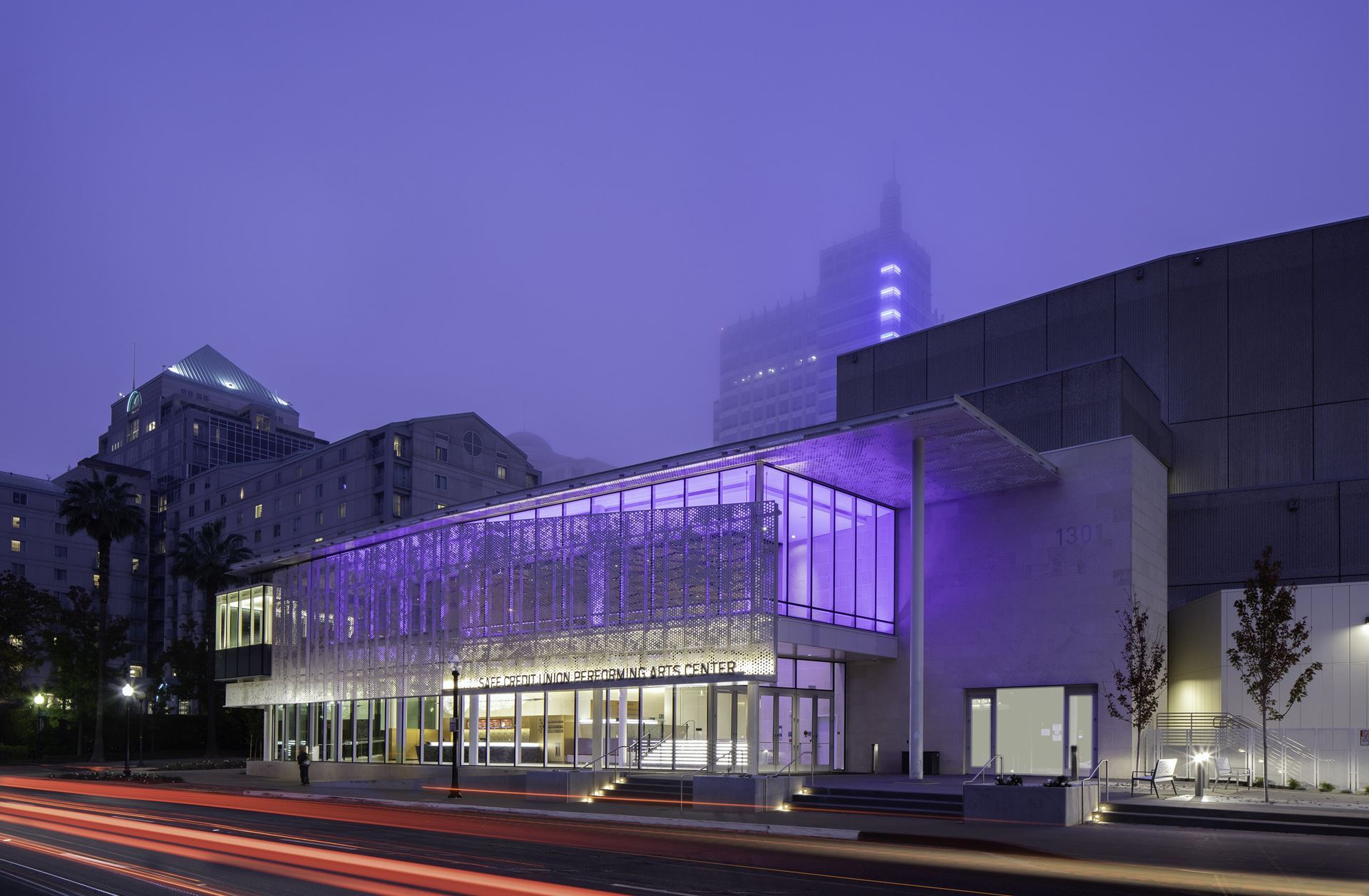
DLR Group | SAFE Credit Union Performing Arts Center
Sacramento, California
Opened in 1974, and without a major renovation since, the Sacramento Community Center Theater was a professional performing arts center in dire need of transformation. The aging brutalist structure was closed off from view, separated from surrounding urban fabric, and with aging services needing a comprehensive modernization to meet escalating requirements of contemporary performance and to present a new face to the public as the premier cultural institution in the state capitol. DLR Group |Westlake Reed Leskosky's design opens the building to the surrounding urban fabric and brings Sacramento’s rich culture of trees into the building.
The key challenge of this project was to preserve the historic, concrete theater building while structuring new narrow additions on every side to be more open to the street and welcoming. Meanwhile, the structure needs to work to current code for a traditional theater volume, which means no consistent roof planes or diaphragms, as the entire structure, both new and existing, are a mix of vertically offset roofs, mezzanines, balconies, gridirons, catwalks, etc.
To allow for completely glazed and open perimeter additions at each side, a special cantilevered column system was selected. The resulting large columns also echo the architectural vision of bringing the Sacramento tree canopy into the building and are celebrated in the lobby spaces by giving column trunks room to fly through double-height spaces. Meanwhile, judicious use of seismic joints protects the original concrete structure from added mass and movement of the additions.
Within the audience chamber, significant long-span roof truss strengthening was conducted to allow the existing roof structure to support numerous new lighting, rigging, and acoustic reflector additions needed by modern theatrical productions. This combined with a re-build of the seating and orchestra pit areas provide a completely upgraded performance experience.
.jpg)
Structural Focus | Sandi Simon Center for Dance at Chapman University
Orange County, California
The Sandi Simon Center for Dance at Chapman University was transformed from a 1920s industrial citrus packing house—the largest and last operating in Southern California, listed on the National Register of Historic Places in 2022—into a modern dance studio. Historic preservation standards were closely adhered to during the building’s seismic upgrade and internal new performance space addition. The engineering and architecture teams designed the interior and exterior rehabilitation plans to preserve character-defining features by:
• Restoring the sawtooth roof structure and clerestory—ensuring visibility directly or indirectly from virtually every corner
• Building space separation to delineate areas—not divide the open warehouse
• Maintaining exposed structural elements as prominent aesthetic features
• Carefully carving out the lower level, providing access to light from the warehouse roof, and adding functional space without affecting the building’s sightlines or historic profile
• Creative planning to maintain historic context, including the return of the roofline’s “Sunkist” signage
The building’s seismic strengthening included a steel tension rod diaphragm addition at the bottom chord of the roof trusses, strengthening of the roof trusses using post-tensioned steel rods, new plywood sheathing added to the interior face of existing exterior walls, addition of new strongbacks to brace historic hollow-clay tile exterior walls that separated the packing house from the historic cold storage, and reframing the historic canopy extending along the north elevation.
A new two-story mezzanine addition, built in a large floor opening, houses a new performance space on the lower level and new classrooms on the second level. The mezzanine’s masonry walls were used as new interior shear walls for the existing floor. Creatively placed opening curvatures, in this floor opening, allow light to extend down to the lower level. The historic wood floor framing was repurposed as wall finish on the new partition walls throughout the lower level.
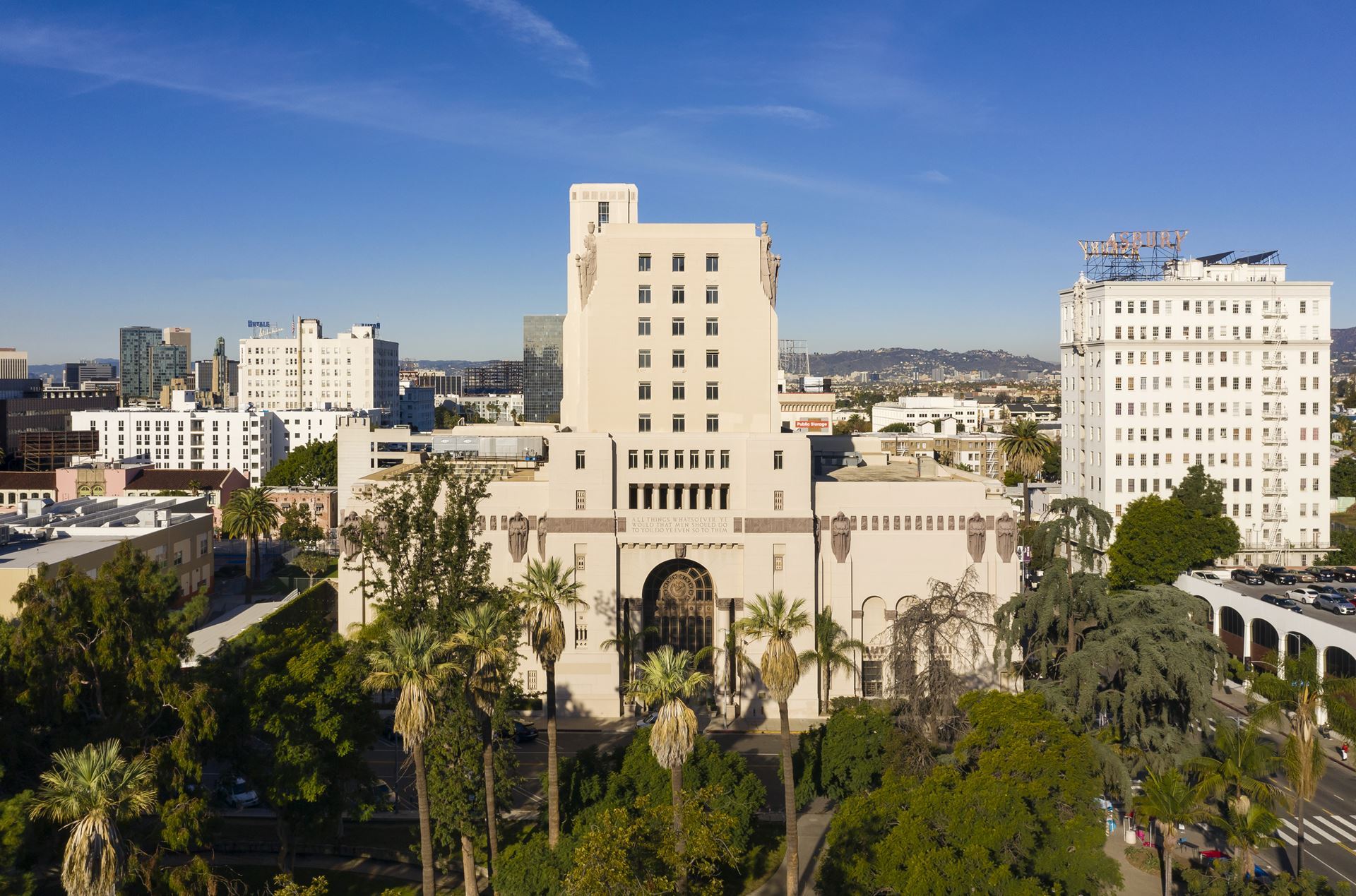
Holmes US | The MacArthur
Los Angeles, California
The MacArthur, formerly known as the Elks Lodge No.99, is a 12-story mixed-use reinforced concrete building in the heart of Los Angeles. The 1925 building was originally intended to host the Benevolent and Protective Order of Elks, which counted many of the city’s most powerful and wealthy among its members. As membership declined, it changed hands and for a time operated as a hotel, first as the Park Plaza Hotel and later the MacArthur Hotel. Its ornamental columns and lavish ceiling murals showcase the signature opulence of Art Deco design. The building is designated as a Los Angeles Historic-Cultural Monument and continues to be an iconic landmark as one of the most filmed buildings in the city.
In 2015, Los Angeles passed the LA Non-Ductile Concrete Ordinance, which required that approximately 1,500 existing buildings, including reinforced concrete construction, undergo a retrofit. To comply with this ordinance, owners of The MacArthur commissioned Holmes to design a full seismic retrofit and provide peer review for the upgraded fire and life safety strategy.
Our team was tasked with improving the building’s seismic performance while preserving the historic fabric, drastically limiting opportunity to introduce new structural elements. Holmes applied a performance-based engineering approach to iterate and fine-tune strengthening solutions. Given The MacArthur’s complexity, limitations, and historic character, various design challenges arose throughout the construction phase that required a nimble and holistic approach to the overall engineering strategy. Holmes devised creative detailing solutions that addressed the client’s schedule, budget, and overall goals.
Retrofit / Alteration
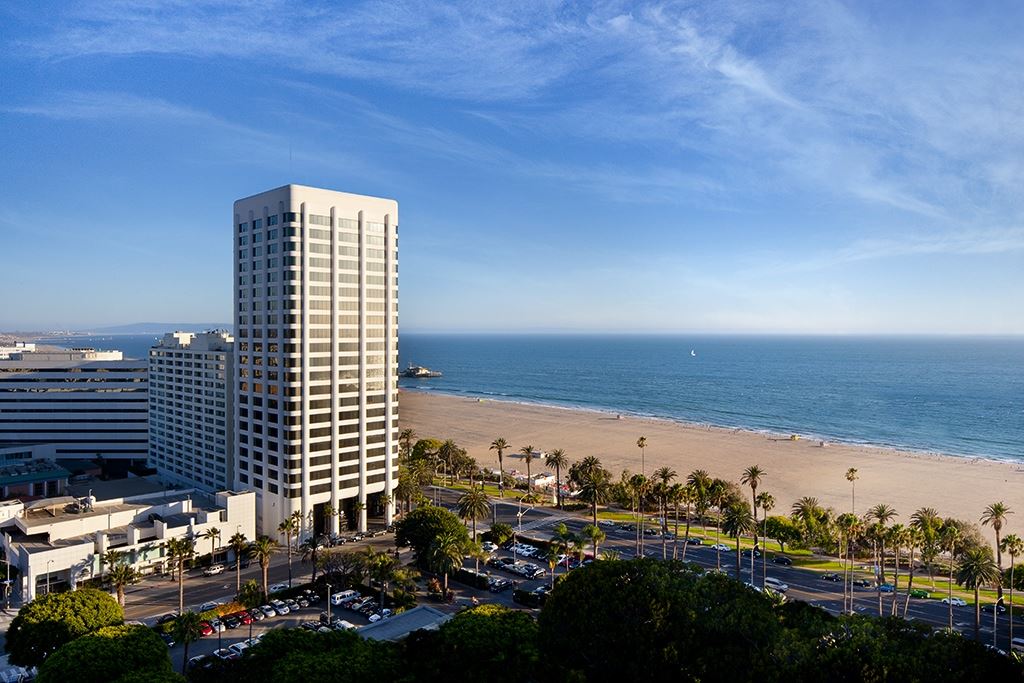
MHP Structural Engineers | 100 Wilshire Seismic Evaluation
Santa Monica, California
At over 300 feet tall and situated on the ocean bluff overlooking the pier and coastline, the 100 Wilshire tower is the tallest building in Santa Monica. The 21-story commercial office building was constructed circa 1971 and utilizes cast-in-place concrete construction, subjecting it to the requirements of Santa Monica Seismic Retrofit Ordinance 2537 for non-ductile concrete structures.
The primary lateral force-resisting system of the 100 Wilshire tower consists of perimeter concrete moment- resisting frames. Although the original Code of Record included ductile detailing provisions for structures over 160 feet in height, the design of the tower incorporated several classical non-ductile concrete vulnerabilities within the gravity system, such as widely spaced rebar ties within the core concrete columns. The structure also includes some unique features that were potentially detrimental to the seismic performance of the building, such as eccentric beam-column joints and compression-only rebar splice sleeves. These aspects of the original design required careful consideration and the use of creative and innovative structural analysis approaches during the seismic evaluation.
An initial evaluation using conventional linear dynamic analysis procedures indicated substantial strengthening needs to attain full compliance with the Ordinance. Potential strengthening work would have required modification to the exterior envelope and aesthetic of the iconic building, considered to be a landmark of Late Modern design, as well as substantial interruption to building operations. To refine the results of the evaluation and reduce invasive strengthening needs, an extensive material testing and investigation program was undertaken, and the structure was evaluated using state-of-the-art nonlinear response history analysis and Perform3D structural analysis software. After multiple rounds of refinement and collaboration with the City’s Independent Design Reviewer, the 100 Wilshire tower was ultimately deemed to fully satisfy the seismic performance standard stipulated by the Santa Monica Ordinance with zero retrofit work required.
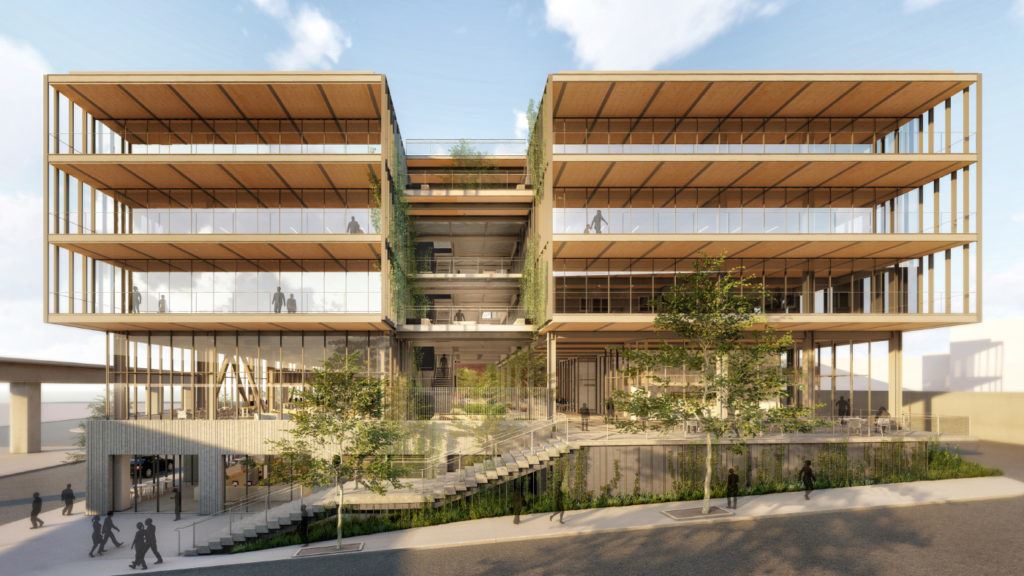
Glotman Simpson Consulting Engineers | 843 N. Spring Street - Chinatown
Los Angeles, California
843 N. Spring Street is a multi-use creative office and retail/restaurant space and the first mass timber building in Los Angeles to utilize a cross-laminated timber (CLT) floor system. It has been fundamental in revising the local building code to allow CLT as a viable seismic-resisting diaphragm and is presented as a case study for the sustainable benefits of adaptive reuse integrated with lightweight structures.
The structure extends 5 stories above the existing ground-level podium with approximately 125,000 SF of interior space and employs a hybrid system consisting of a wide flange steel frame overlaid by CLT panels. Designed as a Type III-B construction with a majority of the structure exposed, every detail of the building was meticulously thought out; from the recessed lighting banks running continuously across the floor plates, the concealed distribution systems buried in the concrete topping, the dramatic 14 ft CLT cantilevered balconies or the lush landscaping and seemingly-floating staircases within the interior atrium inspired by the Oneonta Gorge.
Every detail of this beautifully landscaped building has been carefully thought out. The intricate details of this building ensure that it will be one of the most vibrant and architecturally significant office buildings that Los Angeles will see for many years to come and sets a new standard for architecturally significant office design in Southern California.
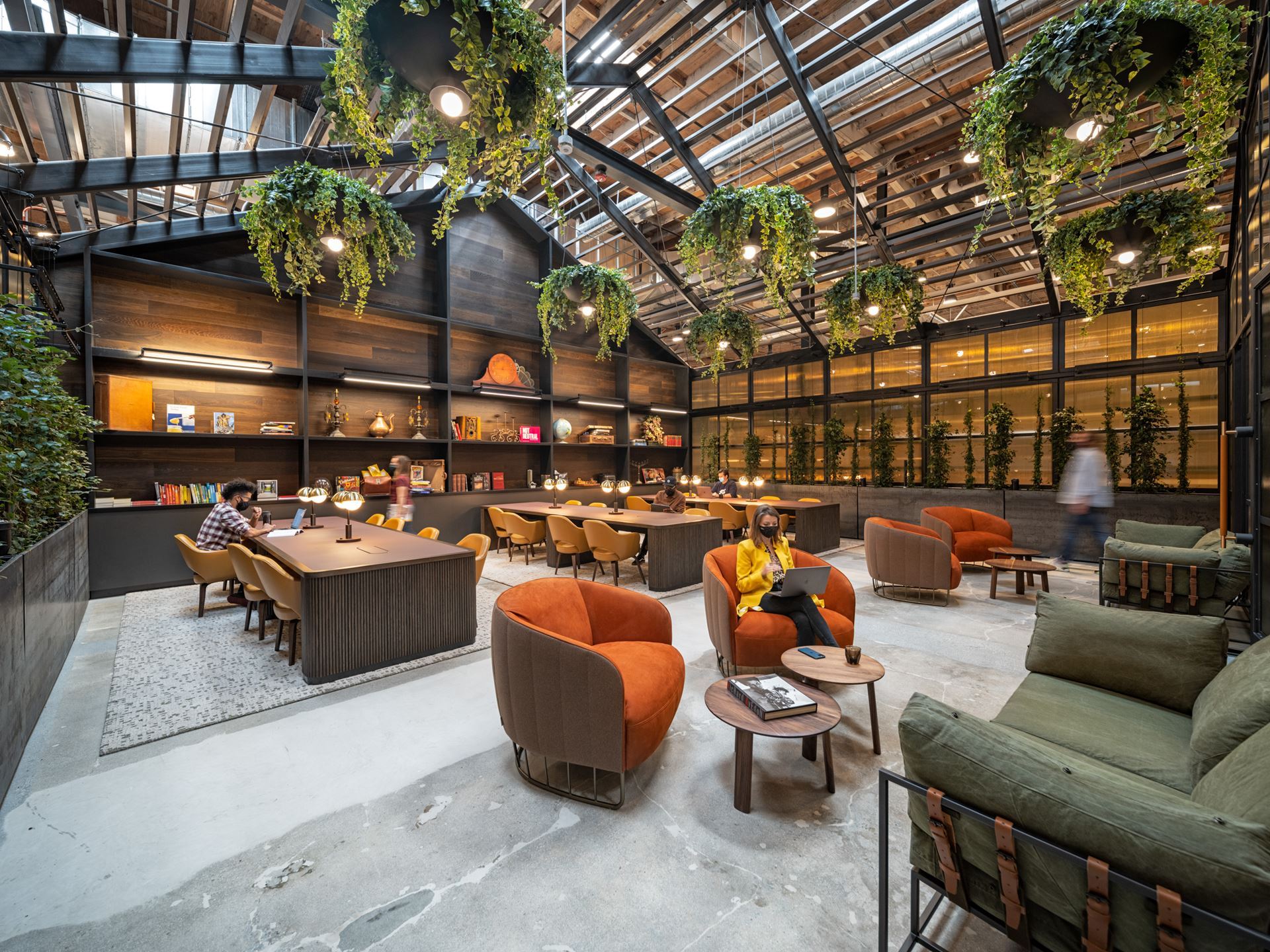
Holmes US | GoodRx
Santa Monica, California
Santa Monica’s historic Pen Factory is the new home of discount prescription drug company GoodRx. To accommodate its rapid growth, the startup relocated its headquarters to occupy part of the large single-story warehouse. Holmes provided structural engineering for its substantial upgrade, working with the design team to the transform the warehouse interior into a state-of-the-art creative office space. Our team skillfully accommodated numerous interior single and double-story office buildouts, introduced generous new skylights, and provided new openings in the interior concrete tilt-up panels to promote flexibility.
Holmes worked with the design team to add warmth to the warehouse facade by providing freestanding partial height walls, a heavy office set-out, feature stair, coffee lounge and juice bar, speakeasy, and meditation area. The structural team carefully coordinated with MEP and IT consultants to incorporate significant structural modifications and buildouts within the existing building to increase natural light, open space, and connectivity between the office & warehouse spaces without triggering a full structural retrofit. Two large concrete panels were removed to allow for better flow within the space. Care was taken to ensure that the new office light framed buildouts were seismically separated from the existing building framing, yet seamlessly integrated to the plan layout.
By maintaining flexibility and providing quick feedback to the design team, Holmes provided back-and-forth suggestions on what was feasible given the existing building’s capacity. Together the design team optimized efficiency within the building while preserving the integrity of the architectural design and programming. The GoodRx Headquarters tenant improvement project demonstrates what is possible with complex existing buildings and highlights the integral role structural engineers play in realizing architectural goals.

Labib Funk + Associates | The Gemma Apartments (Phase I & II)
Los Angeles, California
In recent years, Los Angeles has embraced sustainable approaches of repurposing existing structures in lieu of demolition. The Adaptive Reuse Ordinance (ARO) incentivizes developers to convert existing office buildings to residential developments and revive urban centers with architectural styles that would have otherwise not been fully utilized.
Taking part in this definitive reset, Jamison Properties enlisted the help of Corbel Architects., DFH Architects, and Labib Funk + Associates (LFA) to progress a twofold project—the adaptive reuse of 3540 Wilshire—a thirteen-story, 1950’s era steel office building totaling 240,000 SF (Phase I) and the rehabilitation of an adjacent two-story, 1950’s era non-ductile concrete parking garage (Phase II). Completed in 2021, the adaptive reuse project brought 206 live/work apartments to the office building’s upper floors and ample retail space to the ground level. The façade did not break mid-century modern character; the massing and horizontal bands of the original building were kept intact, both of which were visibly enhanced and reskinned by the addition of distinct, red panels on the northwest corner. Meanwhile, the adjoining parking garage added five floors of wood-frame construction plus a new concrete podium deck to the existing structure and 125,000 SF of residential space, including 123 live/work units, a courtyard, and a rooftop amenity deck. A seamless blend of old and new, the Gemma Apartments revitalized a prominent stretch of Wilshire Blvd in Koreatown, integrating dwelling, work, transportation, and urban life—all within walkable distances.
New Construction
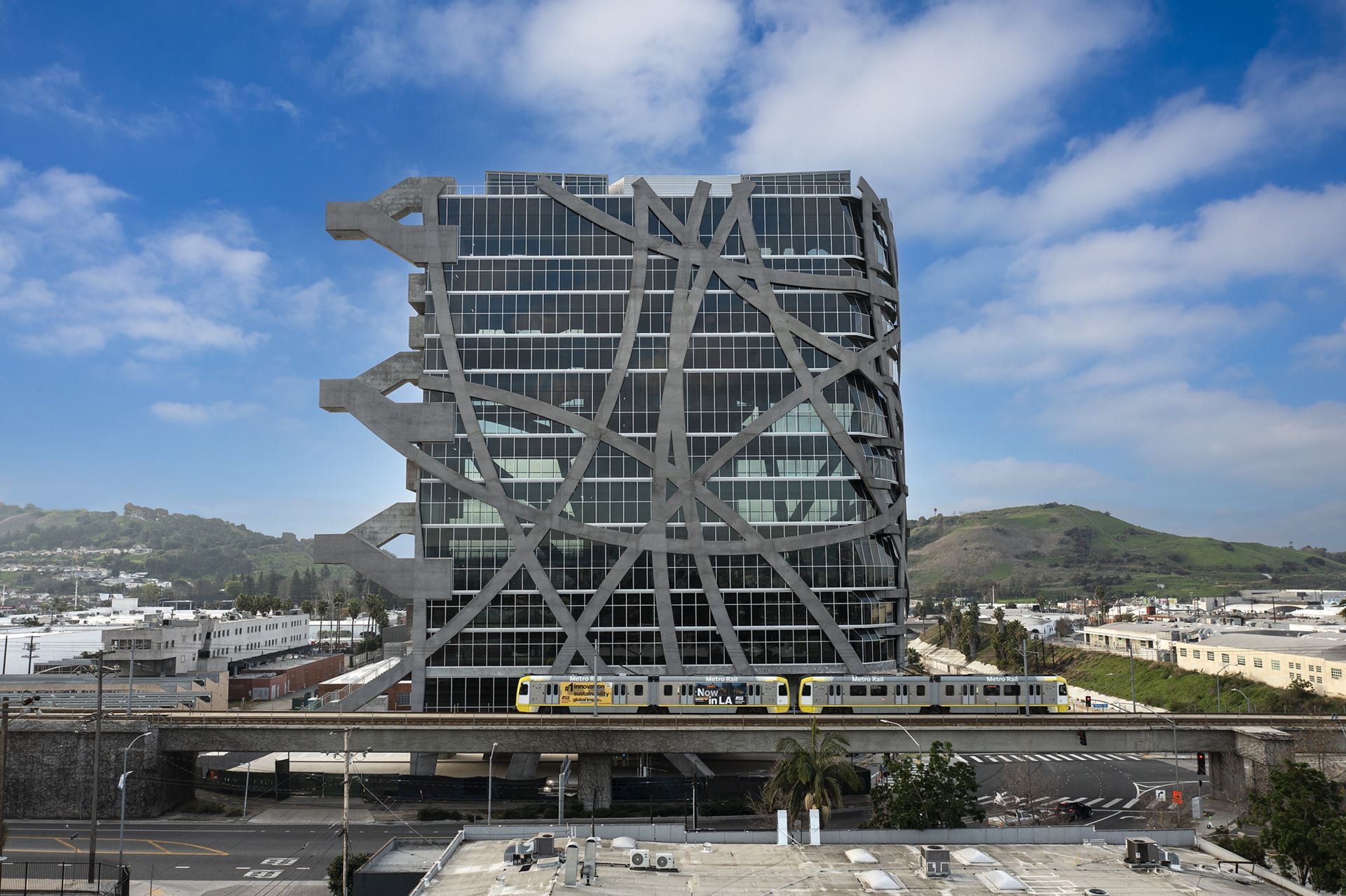
Arup | (W)rapper
Los Angeles, California
Centrally located in Los Angeles, (W)rapper is a 180,500ft2 17-story office building with a striking steel exoskeleton comprised of 5,000ft of curvilinear, built-up plate plate boxes. In collaboration with Samitaur Constructs, Eric Owens Moss Architects, and MATT Construction, Arup provided structural and civil engineering services to bring this complex project to life. Completed in 2022, this is the first exoskeleton building in the city and its structure is comprised of curvilinear steel bands “wrapped” around the tower’s exterior. In addition to its aesthetic appeal, the bands form part of the primary gravity load-bearing and lateral load resisting system to give the building a column-free interior.
As the building is situated near the Newport-Inglewood fault, (W)rapper faces significant earthquake risk, requiring a higher level of coordination and design to ensure structural validation. Arup pursued an alternate means of compliance to the building code, or a performance-based design, to analyze, design, and permit the irregular structure in a high seismic area without undergoing physical testing. To achieve the design, Arup utilized a range of cloud-based digital solutions, including LS-Dyna software, to accurately capture the nonlinear behavior of the structure and design the framing. In addition, Arup worked with metallurgists at Exponent on material and weld fracture mechanics to further validate the band’s behavior.
To ensure the highest level of earthquake resilience, Arup introduced the use of base isolation between the superstructure and subterranean parking garage, consisting of 20 triple-friction-pendulum isolators. Use of isolators reduced the seismic demands on the tower by a factor of four, thereby reducing the structure required to resist the lower demands. In addition, Arup’s proposed switch from the original structural concrete core to a steel-plate shear wall core further reduced seismic loads. Combined these changes saved millions in project costs and allowed the project to move forward.
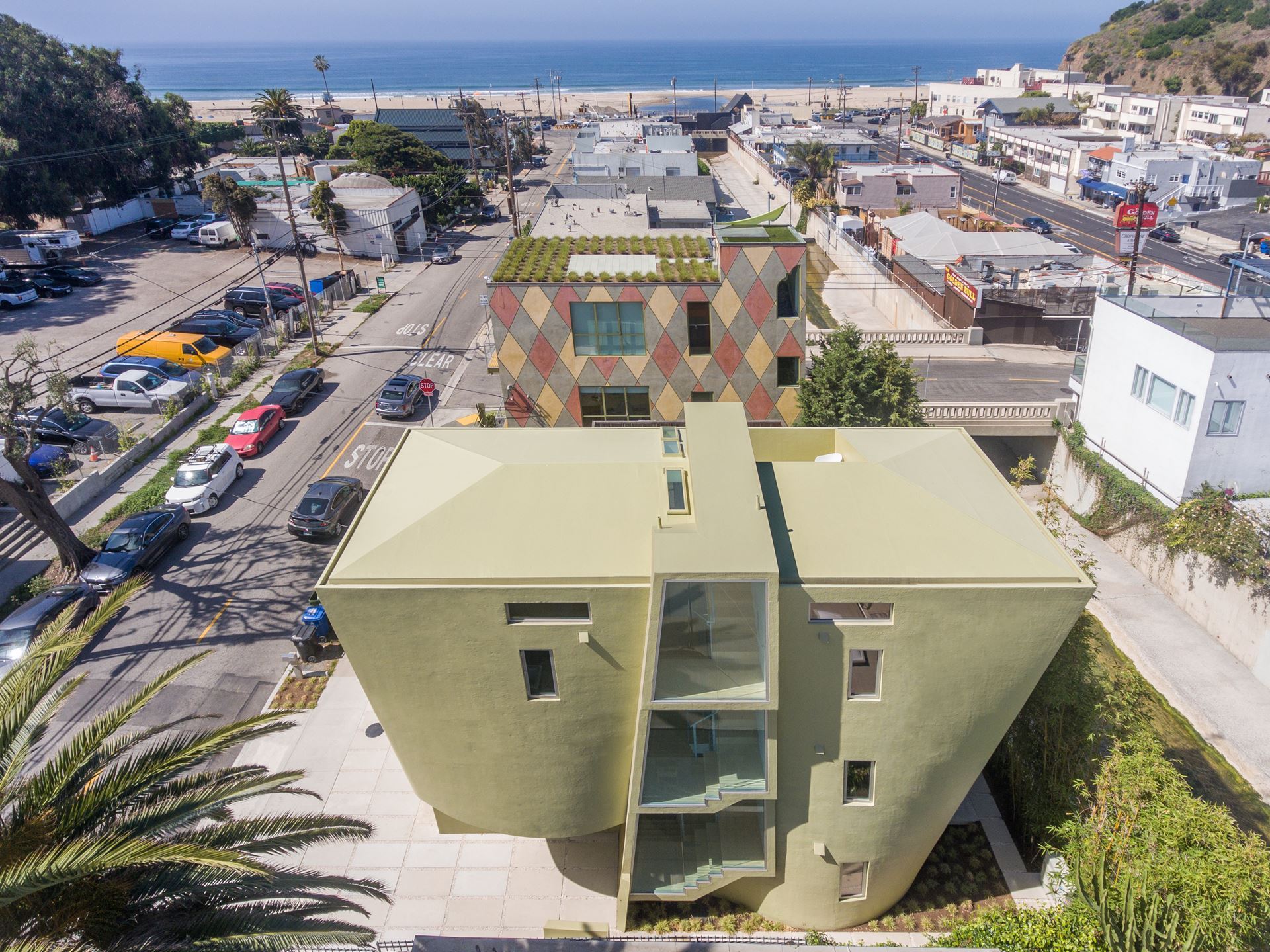
Nast Enterprises | A&M House
Los Angeles, California
The A+M House is a three-story wood framed house located in Santa Monica Canyon on the western edges of the Palisades neighborhood next to a canal, a block from the Pacific Ocean. On the surface, an understated green-looking building with a kind of rough finish, is nothing simple or ordinally. The objective of the owner designer, Eric Owen Moss, FAIA, was to realize a dream: one that he has studied and taught to graduate architectural students for years. A study of a shape shifting structure: The exterior shape of the house transforms vertically – from a single 20-feet by 45-feet rectangle at roof to a variously curving plan at the ground, circumscribing two adjacent 20-feet diameter circles.
The added challenge was that this building was meant to be built with conventional lumber framing, using plywood shear walls, and ultimately be finished with Polycoat Polyeuro Exterior Coating over Aquaseal water proofing membrane. (Typically used as industrial pipe lining) However, as an added twist, the final shape of the ground floor, dictated by parking and zoning requirements demanded a couple of cut-outs, resulting in a shape nicknamed ‘the guitar’.
The three-bedroom home of approximately 33 feet tall, providing two thousand square feet livable space, placed within 30 by 50 feet property – further limited by proximity to a county owned canal, poised to offering curated views of the ocean through carefully located windows, plus a partial roof deck hovering over the open plan third-floor double height ceiling, opposite – but not connected to – a cozy loft space which provides unparalleled living space for the occupants. The family/entertainment room dubbed ‘the bowl’ because of its doubly rounded shape - prominently visible from the street had to be carved with CNC machined from laminated plywood timber joists such that they could inversely support the perimeter of the building above, over the narrow hallway walls below, labeled the “Library”, acting as one of the houses entrances, also known as the ‘the neck of guitar’. Multiple structural engineering software and modeling trials were utilized and developed to efficiently create the composite joists and the rim load transfer members to transfer the complex loading from above to the core, in the most effective and economical way.
In addition to the floor framing, everchanging compound curved wall surfaces - matched on the interior - necessitated each wall framing member to be precision CNC milled and numbered - over 2000 minor parts and 26 major elements such as the floor and rim beams, or the corner posts, where transition from 90-degree angle at the roof gradually becomes the arch on the ground. Special compound connectors had to be designed and detailed to accomplish load transfer around critical boundary members – with high importance of exterior finish sensitivity. The transition from circular base to rectangular roof meant that, wall members approaching the building corners increasingly lean outward. The Structural engineering team coordinated many constructability concerns throughout the design phase, addressed special consideration during each stage of construction, until the release of the temporary tiebacks and cross ties. The majority of temporary and permanent loads occur in the middle of the building - at every level, where a walkway bridge connects rooms on either side, allowing for an open atrium on one side and a central open stairwell on the other. The use of offset framing at the bridge provided passthrough for mechanical and plumbing as well as heavy drag strut action.
The performance and longevity of thinly covered and curving plywood sheathed walls attachments through inward and outward inclination was considered, knowing that Polyeuro Polycoat and the bonding agent tend to shrink, thus potentially pealing/delaminating the plywood. So, in addition to the use of resins between the play wood and studs. The surface of plywood was sprayed with penetrating resin to secure the top laminate to the body of the sheathing. During the evaluation of sheathing connectors, residual stresses due to curvature and warping/bending of plywood was considered. The successful completion of this project is embodiment of high level of ingenuity, research, challenge, coordination, and discovery.
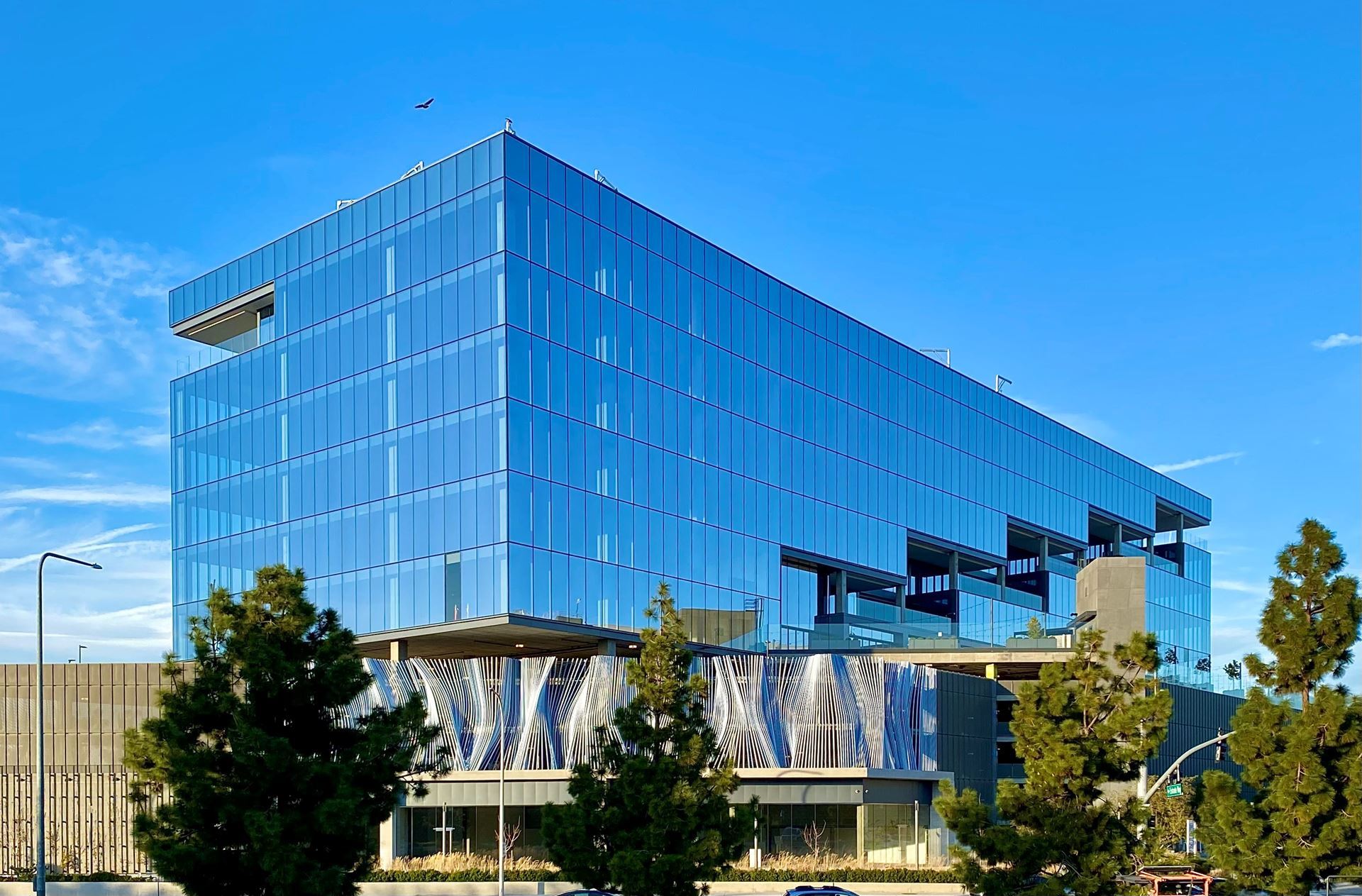
Saiful Bouquet | Entrada
Culver City, California
At the conflux of Culver City and Playa Vista, Gensler's Entrada creative office reflects the innovative synergy of Silicon Beach, offering the city's tech and media scene cutting-edge design, ample amenities and premier views. Saiful Bouquet served as the Structural Engineer of Record for the 11-story, 813,000-sf glass box structure, which includes 273,000-sf of creative office space over 1,000 parking stalls, features flexible floor plans, private outdoor terraces for indoor-outdoor workspace, and a 14,000-sf elevated landscaped open air sky deck. The team's innovative use of BubbleDeck, a flat plate voided concrete slab system, allowed the office space to have the required long span that stacked with the parking levels below, while providing the clean flat soffit that was important to the client, LPC West The use of BubbleDeck, where hollow plastic balls are inserted into the slab replacing the least effective part of the concrete slab, allowed reduced floor-to-floor heights, and significantly reduced the building weight, which in turn, reduced the seismic forces and the foundation loads. Dual cast-in-place concrete shear wall cores provide the lateral resistance for the tower.
- Special structural features include:45-ft span reinforced concrete flat plate void slab construction.
- The voids are created by bubbles manufactured by BubbleDeck North America.
- The use of the bubble voids significantly reduced the self-weight of the building, thereby significantly reducing seismic forces and foundation loads.
- Hanging the corner bay of all 6 office floors from 10-foot-tall post-tensioned cantilever roof beams to create a column free space at the ground floor entrance to retail area.
- Column free corner terraces at the top-most office floor by providing 45 ft cantilever post-tensioned beams at the Roof level.
.jpg)
Thornton Tomasetti | Google Bay View
Mountain View, California
Located in a high-seismic zone, Google’s Mountain View corporate campus includes three distinct buildings that feature expressive sweeping canopy roof structures. The canopies are shallow inverted shell structures - which do not achieve their full stiffness until fully erected - which presented challenges to the fast-track schedule. The unconventional canopy structures also required an innovative design approach.
Thornton Tomasetti provided structural design services to BIG, Heatherwick Studio & Adamson Associates and construction engineering services to Whiting-Turner and Schuff for the three-building campus.
Since the roof is effectively a series of large inverted shells it was not feasible to crane the panels into place in one piece. We collaborated with the steel fabricator and optimized the design to suit their workflow, which involved assembling the roof panels on bolsters at low level and strand-jacking them into place. This design proved much more effective than craning sub-assemblies of the canopy into place in their final location. We also provided erection engineering services to the fabricator to devise the jacking methodology and design the shoring, bolsters, temporary jacking anchorages and sliders.
Performance-Based Seismic Design employing state of the art analysis techniques demonstrated that the structure exceeds code requirements and satisfied the rigors of peer review during permitting whilst maintaining schedule.
Erecting the roof canopy steelwork at low level and strand-jacking into place proved much more effective than craning elements of the canopy into place in their final location. Careful planning ensured that the pieces went together quickly on site while meeting steel tolerances.
The biggest single-hoisted assemblies included more than 180,000 square feet of roof structure covering a footprint of nearly 500 feet by 500 feet, setting a western hemisphere record for the largest roof lift by size and number of strand-jacks used at one time.
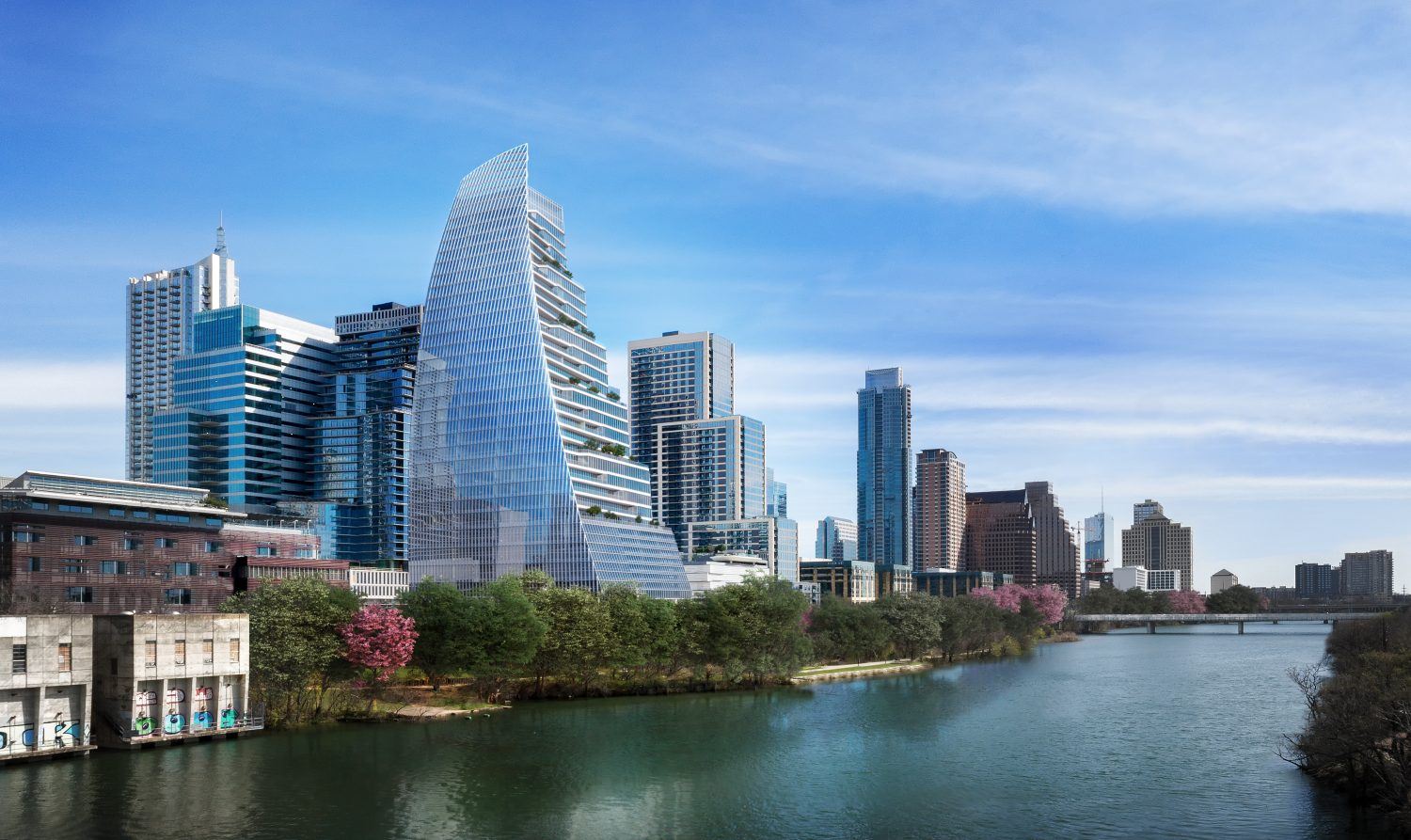
Thornton Tomasetti | Green Water Block 185, Google Austin
Austin, Texas
Green Water Block 185 is a 1.5-million-square-foot, 36-story concrete office tower with a unique structural design for each floor and a sail design along the west façade. The building includes 745,000 square feet of office space and 10 levels of above-grade parking spaces.
The distinct sail shape on the western façade and a stepped and terraced southern façade posed some unique structural challenges. The shape is achieved through sloped structural concrete columns on the tower’s perimeter, which required careful coordination between Structural Engineer Thornton Tomasetti, the architects and the curtain wall design-build contractor, Permasteelisa.
With a series of balconies at every fifth floor, the setbacks on the southern façade are made possible by strategically placed columns, the majority of which avoid transfer beams. A concrete core provides the tower’s lateral stability and houses elevators, stairs and MEP back-of-the house functions.
Significant planning went into the column grid and layouts to accommodate the office and above and below-grade parking programs. The chosen system entails a generous 45-foot span in the east-west direction, and 30-foot span in north-south direction.
The resulting leasing bays allow for open interiors with an efficient layout and provide for ample space for amenity areas. Large areas of the slabs have also been prepared without post-tensioning to accommodate future modifications, such as communicating stairs or slab openings. The below-grade parking system was optimized by adding a column to each bay, such that the typical bay was reduced to 30 feet by 30 feet. This solution allowed for a flat mild reinforced slab system to be used below grade, which minimized the vertical floor-to-floor dimension.
The project achieved LEED Platinum certification.
The project team also included Trammell Crow Company (design manager), Pelli Clarke & Partners, STG Design (architects), and DPR Construction (general contractor)
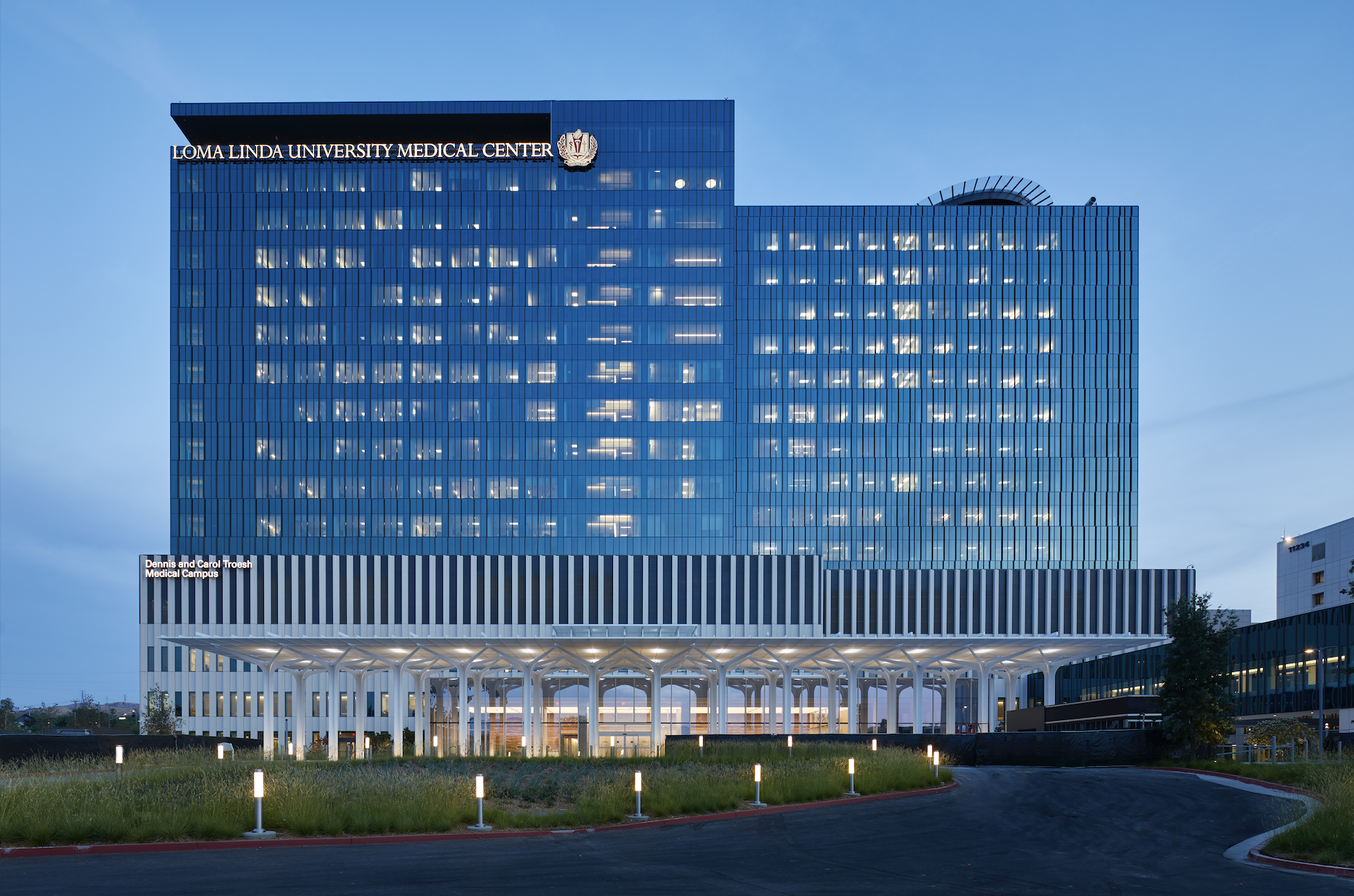
Arup | Loma Linda University Medical Center (LLUMC) Replacement Hospital
Loma Linda, California
The Loma Linda University Medical Center (LLUMC) Replacement Hospital project is a new 480-bed 1,000,000ft2 17-story acute care replacement hospital located in Loma Linda, CA. In collaboration with Loma Linda Health, NBBJ Architects and McCarthy Building Companies, Arup provided structural, mechanical, plumbing, fire, and civil engineering services to bring this complex project to life. Completed in 2021, this project brought the LLUMC campus in compliance with the California Hospital Safety Act and is an OSHPD-1 acute care facility providing Level 3 Trauma services to San Bernardino County. At approximately 260 feet tall, the Hospital is currently the tallest hospital in California.
As the hospital is situated only 1km from the San Jacinto fault and 5km from the San Andreas fault, this critical care facility faces significant earthquake risk and high seismic demands, requiring a higher level of coordination and design to ensure enhanced structural performance. Arup pursued an alternate means of compliance to the building code, or a performance-based design, to analyze, design, and permit the hospital structure under the stringent requirements of OSHPD. To achieve the design, Arup utilized a range of cloud-based digital solutions, including LS-Dyna software, to accurately capture the nonlinear behavior of the structure and demonstrate design compliance against enhanced performance objectives required for OSHPD-1 facilities.
To ensure the highest level of earthquake resilience and hospital safety, Arup implemented an integrated state-of-the-art structural system consisting of 126 triple-friction-pendulum isolators, 104 fluid viscous dampers, buckling restrained braces (BRB) and SidePlate moment frames. The use of isolators reduced seismic demands by a factor of two on the hospital superstructure while the coupling of supplemental fluid viscous dampers controlled overall building displacements and reduced reliance on the isolator system for system damping. Combined these strategic implementations saved millions in project costs and allowed the project to move forward.

John A. Martin & Associates | Orange County Museum of Art
Costa Mesa, California
The Orange County Museum of Art (OCMA) is a central component of the Orange County, California arts scene. OCMA’s new permanent space, designed by Morphosis Architects and located in Costa Mesa, celebrated its public opening last October after three years of construction, and nearly a decade of planning and design.
The museum’s location, adjacent to 3,000-seat Segerstrom Hall, a Performing Arts Center, represents the synergistic impact of art, architecture, and engineering acting together. It also serves as the final component of what was envisioned as a multi-disciplinary arts campus. With nearly 25,000 square feet of exhibition galleries—approximately 50% more than its former location—the new 52,000-square-foot museum will allow OCMA to organize major special exhibitions alongside spacious installations from its collection. The design, which complements and responds to the undulating façade of the neighboring concert hall and supports an outside-in and inside-out experience, also features an additional 10,000 square feet for education programs, performances, and public gatherings, as well as administrative offices, a gift shop, and a café.
OCMA’s steel structure enables the project’s complex architecture while meeting critical safety and cost thresholds. Highly visible elements include large, column-free gallery and mezzanine spaces that support heavy plaza loads, non-orthogonal architectural elements that cantilever in places more than 30’ off the primary structure, and a highly visible cantilever-trussed classroom wing that frames a highly visible public space. Less visible but no less important were the requirements to withstand Southern California’s significant seismic forces. In many instances, we used elements that were part of both the gravity and lateral load paths, providing sustainable and economically fabricated framing to span the ground floor gallery, while maintaining strength-to-weight requirements for the project’s unique architectural elements.
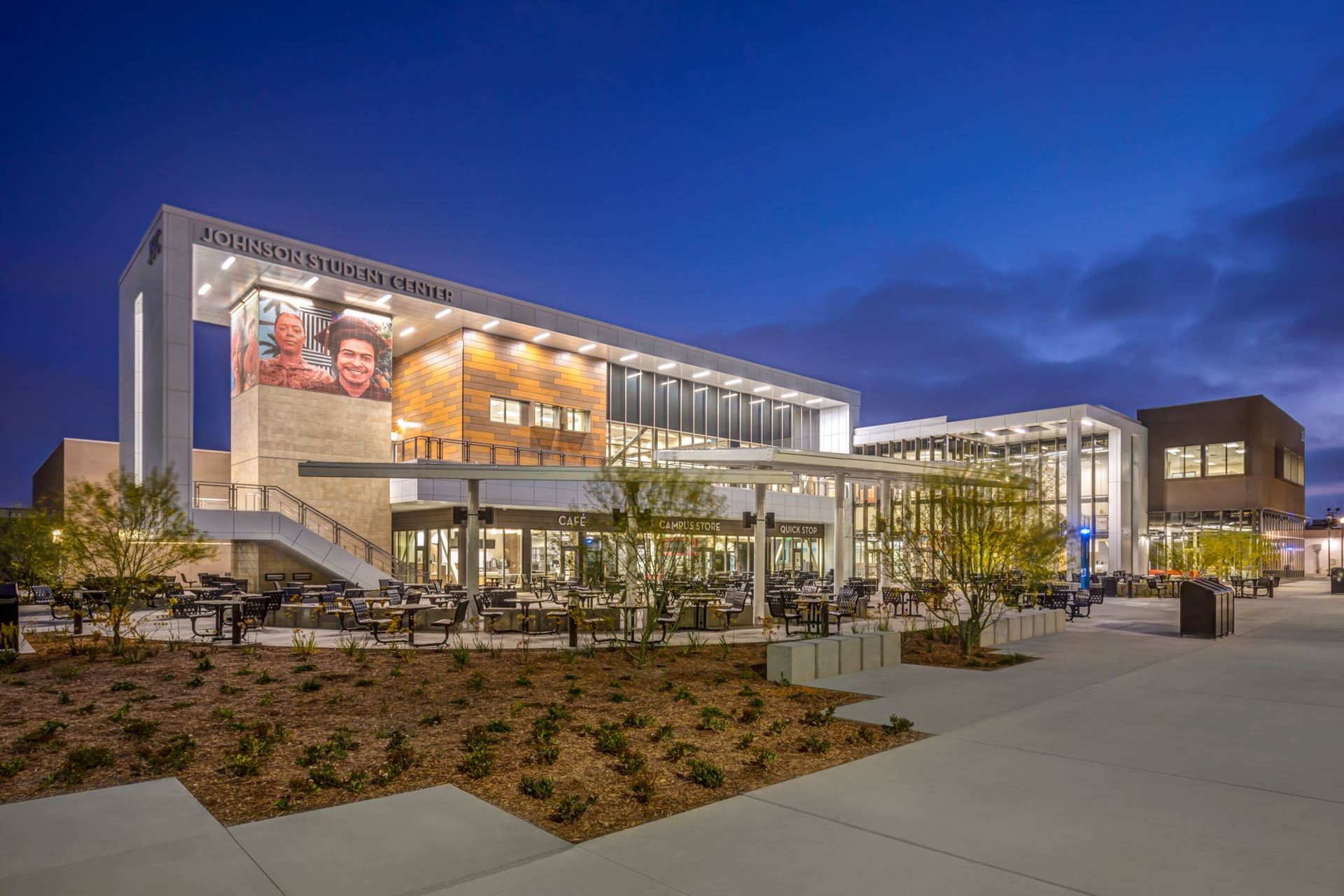
MHP Structural Engineers | Santa Ana College Johnson Center
Santa Ana, California
Structural ingenuity and a collaborative team approach led to the successful completion of the new Johnson Center at Santa Ana College, a student services facility that serves as the focal point and hub of the campus. The Student Center is a two-story, 64,000-square-foot building housing financial aid offices, a campus bookstore, a health and wellness center, a café, and a lounge area complete with billiard and ping-pong tables for students to enjoy.
- The elaborate architectural design of the building incorporated many unique challenges for the structural engineering team including the following:
- Feature stair: The exterior feature stair of the building wraps an elevator core and is supported by long cantilevered stringers allowing the space beneath the stair to be free of columns.
- Grand atrium entrance: The main entrance to the building incorporates a tall two-story high volume atrium space. The atrium design presented structural challenges including long unbraced columns, tall curtainwall glazing, skylights, and re-entrant corner discontinuities at the second-floor diaphragm.
- Raised roof at conference rooms: A raised roof was incorporated above the second-floor conference spaces to accommodate higher ceilings and more daylighting into the building. Transfer braces were designed to provide diaphragm continuity between the low and high roofs.
- Tensioned fabric shade structure: MHP was retained by the project’s shade-structure manufacturer to engineer a tensioned-fabric open air canopy supported by architecturally exposed structural steel tube columns and beams.
MHP designed a structural steel system that elegantly addressed architectural features including multiple roof elevations, a suspended column-free exterior feature stair, grand atrium spaces, tall curtain walls, exterior cantilevered walkways, and tensioned fabric shade structures. MHP collaborated with the Architect to expose the structure, adding to the appeal of the building and providing a great example of how structure can be incorporated and emphasized in architectural designs.
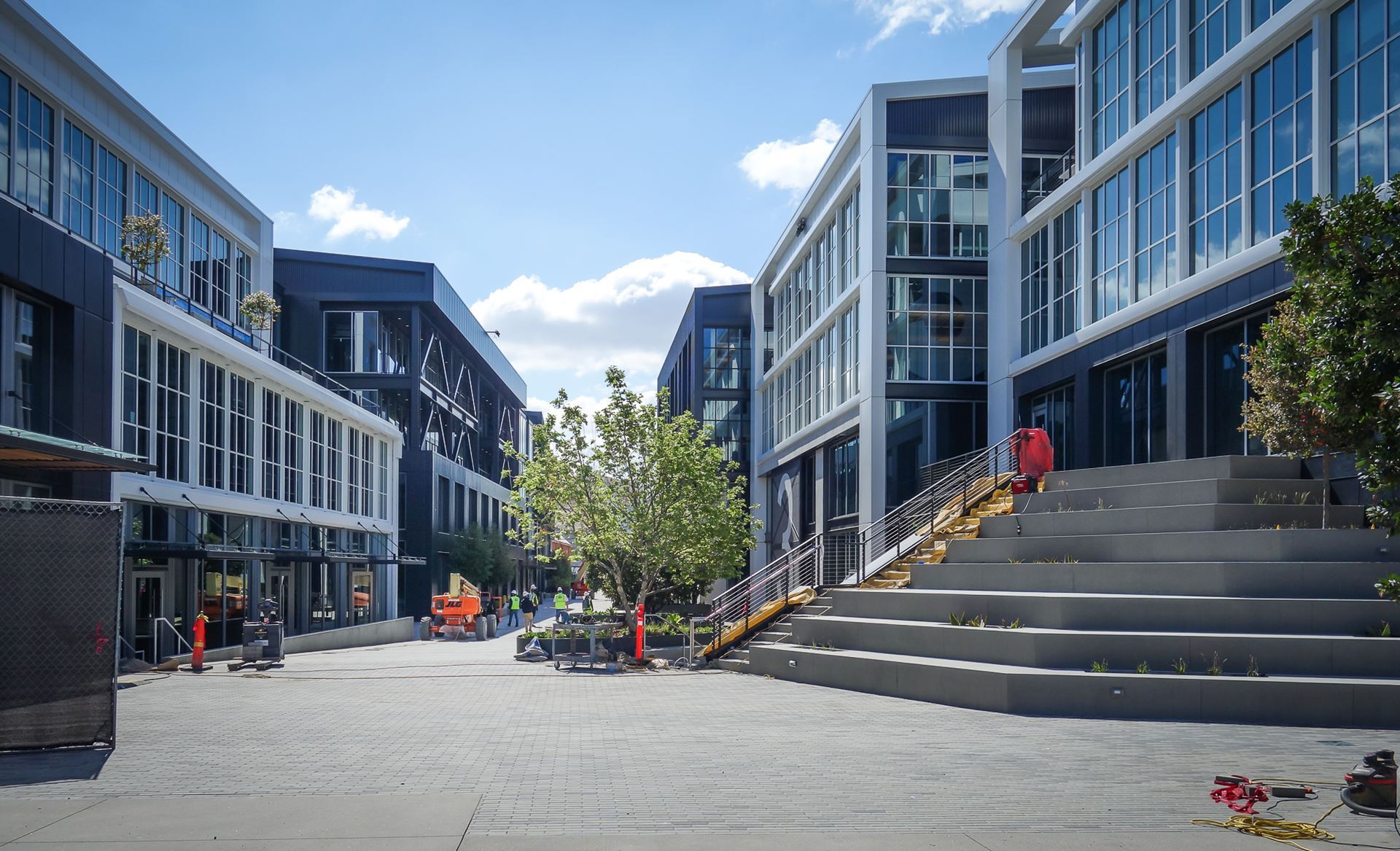
Structural Focus | The Culver Studios Innovation Project
Culver City, California
The historic Culver Studios campus stands as evidence of the rich history of Culver City movie making. It has hosted iconic productions such as the original King Kong (1933), Citizen Kane (1940), and The Matrix (1999).
Founded in 1918, when Thomas H. Ince, a silent movie mogul, purchased 11-acres on Washington Boulevard from Harry H. Culver, the Culver Studios campus was designed to be beautiful and highly functional. The colonial-type administration building (the “mansion”) and gardens provided a pleasing view. The studios were innovative and advanced, with modern equipped sound stages and outdoor sets.
In 2017, Hackman Capital Group, announced the “Culver Studios Innovation Project,” a campus- wide revitalization plan for continued and future studio use—doubling its usable size. The project provided 500,000-SF of new office space, which currently leased by a single high-profile tenant.
This large-scale innovation project includes:
- New underground parking structure, encompassing entire construction footprint.
- Four, new 4-story office buildings and a new exterior courtyard sit atop the new underground parking structure. These buildings are new steel buckling restrained braced frame structures.
- New above ground parking structure.
- New vehicular tunnel.
- Various site enhancements, providing a cohesive studio campus feel.
- Desirable modernization amenities provided throughout the campus, while still paying homage to the iconic campus’ history.
- One, new 4-story concrete office building constructed for a high-profile tenant at the campus’ east end.
Many historic structures and sound stages remain on campus. The new innovation project provided additional campus space, while incorporating these historical buildings for continued use as a production studio. The new structures with the incorporation of extensive site improvements, provide a modern and functional space for employees.
The Culver Studios Innovation Project continues the historic campus’ story for the next generation of filmmakers.
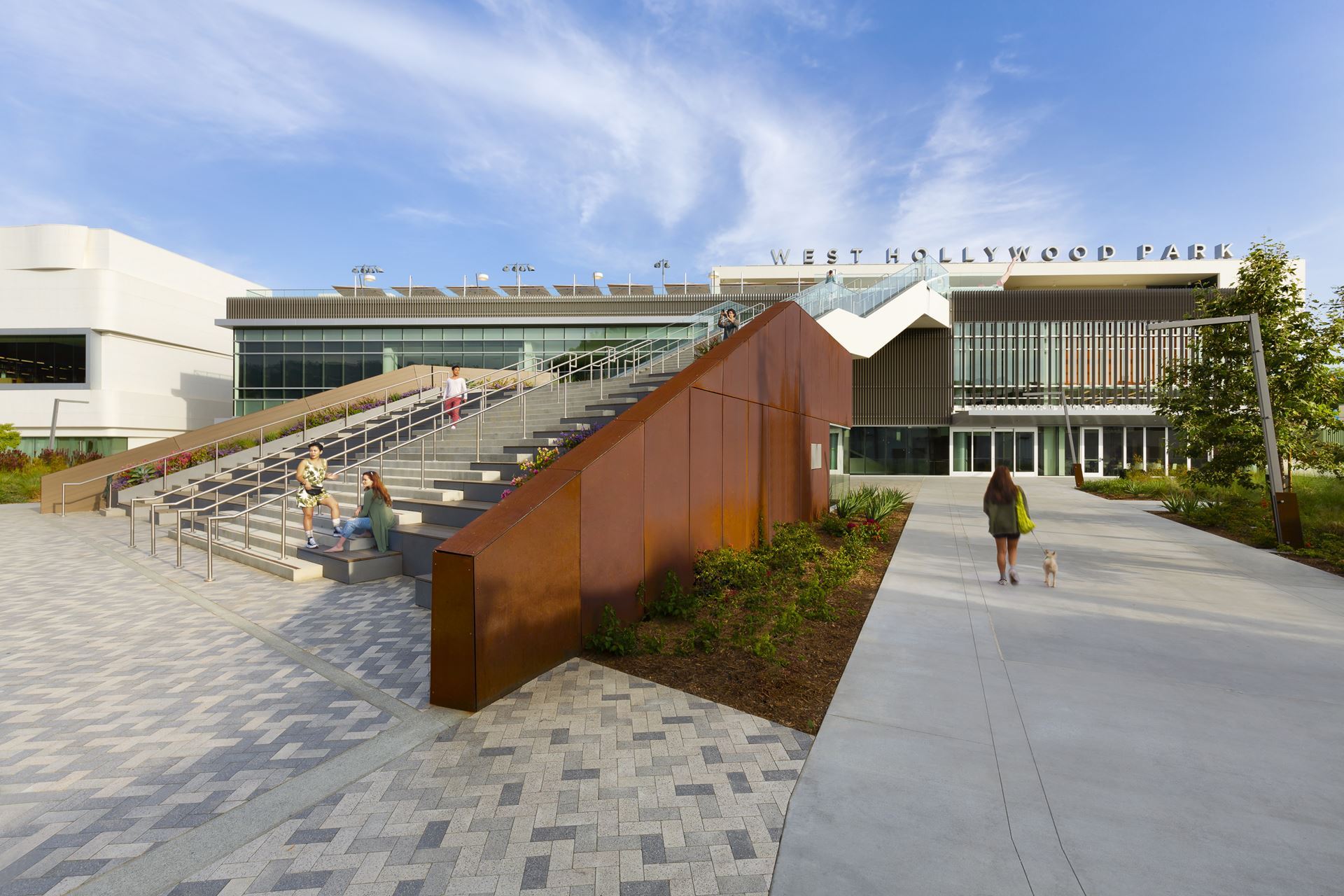
LPA Design Studios | West Hollywood Recreation and Aquatics Center
West Hollywood, California
The West Hollywood Aquatics and Recreation Center (ARC) completes the West Hollywood Park Master Plan and provides a new center for social and recreational activity for the City’s 35,000 residents. The new facility dramatically enhances community recreation facilities for West Hollywood while connecting to and preserving open space in the revitalized West Hollywood Park --- the only significant open space in the city. The ARC comprises three separate structures, each with its own unique structural engineering challenges.
The four-level Recreation Center provides much needed indoor and outdoor community recreation and wellness space including a multi-purpose gymnasium, rooftop competition and recreational pools, along with locker rooms and an automated parking facility on the tightly constrained urban site. The constrained footprint, pinned in by existing buildings and city streets, led to a vertically stacked program with the top-level pool deck suspended above the expansive column-free sports courts which sit above the ground level automatic parking facility. The pool deck level spans 100 feet by 160 feet column-free over the sports courts and is supported by an innovative two-way steel truss system beneath the pools. A fifteen-foot deep by four-foot wide “mega-truss” between the two pools limits the two-way truss span to 100 feet. To provide connectivity between the Recreation Center and the new Community Center located on the other side of El Tovar Place, a public street, the upper levels of the Recreation Center cantilever thirty feet over the roadway, linking the rooftop aquatics center and existing rooftop tennis courts to the open space of the community park through raised observation and recreation decks.
The new two-story Community Center includes meeting rooms, staff offices, outdoor recreation/yoga decks, and a rooftop respite garden. The Community Center sits on top of an existing concrete parking structure that required significant structural reinforcement to support the added weight of the new building. The design team worked closely with the City of West Hollywood and the general contractor to develop design solutions that allowed the existing parking structure to remain open during construction.
In addition to the Community and Recreation Center structures, the ARC includes a three- story outdoor Grand Stair which links the open space of the community park to the raised observation and recreation decks on the roof of the Community Center. The seventy-foot-long stair structure bears on the top deck of the Community Center but is seismically independent, relying on a large horizontally cantilevered steel truss to anchor the base of the grand stair to an elevated structural plinth in much the same way the stair anchors the new ARC facility to a reenergized West Hollywood Park and the community it serves.


